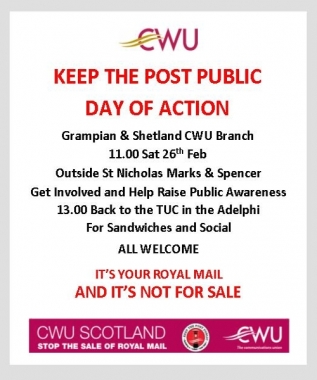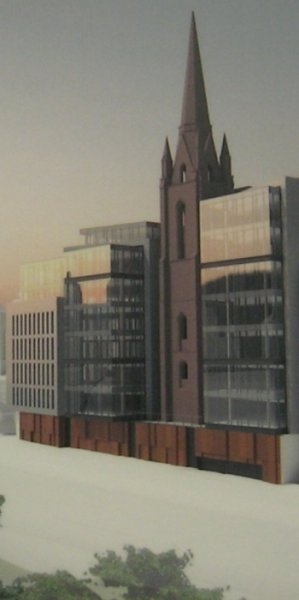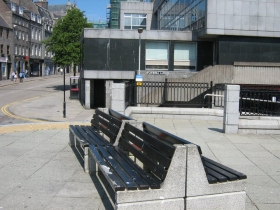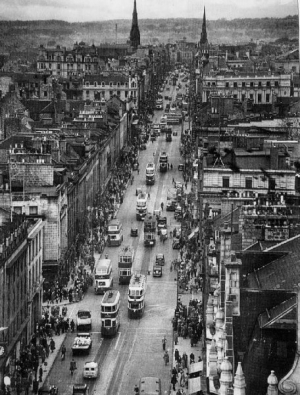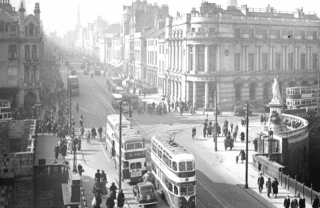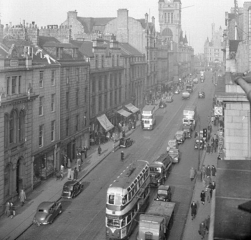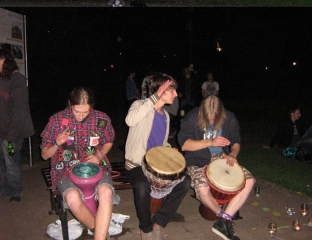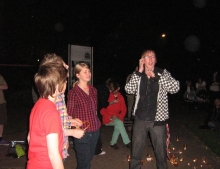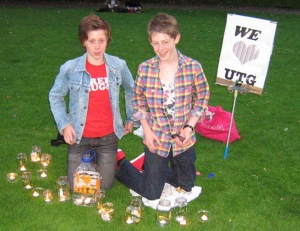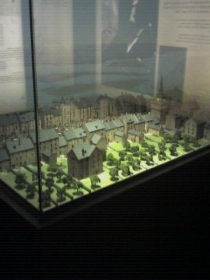By Alex Mitchell.
There is widespread concern about the dingy and run-down state of Aberdeen’s principal thoroughfare of Union Street which runs all the way from Holburn Junction to the Castlegate and the town end of King Street. This is manifest in the number of empty shops and in the distinctly low-rent character of many of such shops as there are.
It seems the more odd that this situation has developed during some thirty years of oil-boom prosperity, low unemployment and substantially-increased population.
If one thinks back to the Union Street of the nineteen fifties and sixties, the following comes to mind: Union Street was jam-packed with shoppers along its entire length every Saturday, as was also St Nicholas Street/George Street. People dressed up to go ‘doon the toon’, and you met everyone you knew in Union Street. In that sense, Aberdeen really was a village. The open-air markets in the Green and Castlegate were very much going concerns. Buses went all the way from Hazlehead to the Sea Beach and back again, via Queen’s Cross, Union Street and the Castlegate, which served as the city’s main bus interchange, where you nipped off one bus and on to another.
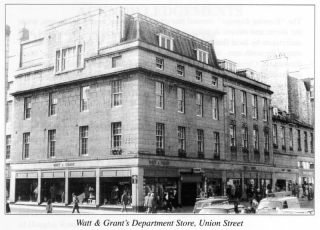
As a result, far more people had reason to go to the Castlegate than nowadays. Union Street and St Nicholas Street/George Street were full of interesting, up-market shops: grocer Andrew Collie & Co. Ltd. at the corner of Union Street and Bon Accord Street; Watt & Grant’s department store; McMillan’s toy shop, under the Trinity Hall; Woolworth’s, backing on to the Green; Falconer’s, Isaac Benzie’s, the Equitable, the handsome and elegant old Northern Co-op building in Loch Street; the Rubber Shop.
So what happened? Much of the population moved out of down-town tenements and into the new housing estates and suburban residential developments, ever-further from the city centre. Car ownership became the norm, and car-borne customers prefer shops they can park next to. Supermarkets became superstores and greatly extended their range of merchandise, destroying one specialist retailer after another. Butchers, bakers, fishmongers, hardware and electrical stores, shoe-shops and, most recently, pharmacists, bookshops and record shops have all been subsumed into superstores.
The obvious way for the city-centre to fight back was to build down-town malls like the St Nicholas and Bon Accord shopping centres
Superstores and their car-parks require huge expanses of land and prefer edge-of-town locations where large sites are available and cheap and accessible for both customers and delivery lorries. DIY sheds like B&Q, furniture and carpet stores and ‘big box’ retailers like Curry’s similarly prefer edge-of-town retail parks.
Edge-of-town retail complexes, such as that at Garthdee, may be banal, unhistorical and characterless, but they are also convenient as to access, offer easy and free parking, and are generally clean, safe and relatively easy to secure against break-ins and vandalism. The obvious way for the city-centre to fight back was to build down-town malls like the St Nicholas and Bon Accord shopping centres. These offer the kind of accommodation retailers want, and are relatively secure overnight, but they may tend to abstract business and custom from the High Street. The case is unproven. Without the down-town malls, the major retailers might have moved out of the city centre altogether. Or they might not.
If, however, the supply of retail premises outruns the demand, it follows that the less attractive premises and locations will become hard-to-let, the rent obtainable falls, lower-status tenants have to be accepted; ultimately, premises may become unlettable on any terms. This is what seems to have happened in the west end of Union Street, and not only there.
We are assured that Aberdeen is not oversupplied with shops, but there have been significant increases in the down-town stock of retail premises in recent years, e.g., the Academy in Belmont Street and the Galleria in Bon Accord Street, neither of which were quick to fill up with tenants. The proposed Bon Accord Quarter will substantially increase the capacity of the present St Nicholas and Bon Accord malls and the Union Square development at Guild Street comprises some sixty new retail premises.
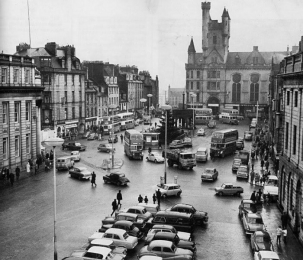
What else happened? Down-town, the general decline in church attendance after the First World War, combined with the exodus of population from the city centre, rendered many churches redundant. Similarly, whatever else we may say about the banks, they did put up some very handsome and impressive buildings. But, by the 1990s, the Bank of Scotland had abandoned its splendid and purpose-built 1801 premises at the corner of Castle Street and Marischal Street, as did the Clydesdale Bank its 1842 Archibald Simpson premises at the corner of Castle Street and King Street.
What was once the centre of business activity in Aberdeen was so no longer. Aberdeen Journals moved from Broad Street out to Lang Stracht. Aberdeen University withdrew from Marischal College and the Student Union (and Bisset’s Academic Bookshop) closed down. The Robert Gordon University moved out to Garthdee.
There never was a time when things stood still. Old trades and occupations become obsolete, redundant or move elsewhere, often when displaced by newer, more profitable activities in the Darwinian contest for the use of economic resources, land, labour, capital etc. There are no fishing boats in Aberdeen harbour now because they have been replaced by oil-industry vessels. Planning applications for change-of-use are the normal and desirable state of affairs. But neighbourhoods and communities go into a decline when long-established firms and industries fade out and fail to be replaced by new enterprises and activities, or are replaced by activities which are in some way damaging or undesirable.
bars, nightclubs, etc., are a youth-orientated business, and the relevant age-group is shrinking as families move out of the city
The increased number of vacant retail premises in Union Street results from the fact that fewer tenants are moving in than are moving out; there is a net exodus of retailers. The sad truth is that Union Street is not nowadays that good an environment in which to try to run a shop.
Old buildings and ground-floor premises are difficult to make secure against break-ins and vandalism. Delivery access for lorries is difficult. Shop staff and customers are harassed by drunks, beggars and drug abusers. Shop doorways, windows and their surroundings are often in a filthy state at the start of each day’s business. It is difficult to find and retain staff who will put up with this. It is not surprising if retailers follow their customers and withdraw to the relatively clean, safe and secure environment of the down-town malls and edge-of-town retail parks.
Aberdeen has generally been a better-run city than most. But the situation described arises from the non-delivery, or inadequate performance, of very specific council and governmental responsibilities, e.g., to maintain law and order, to enforce the law, e.g., against drinking in public places, to deal with anti-social and criminal behaviour, to collect the rubbish and clean the streets and pavements. Putting down the odd tub of begonias is not enough.
As banks, churches and big stores have withdrawn from Union St, so mega-pubs and bars, nightclubs and fast-food providers have moved in. To an extent, the new arrivals have been welcome, occupying old buildings which would otherwise have remained empty and neglected. In addition, some of this may be regarded as legitimate change-of-use, in response to changing tastes and lifestyles.
Similarly, there is a place for pubs, bars and nightclubs; but perhaps for fewer of them, and of a different character. The bars, nightclubs, etc., are a youth-orientated business, and the relevant age-group is shrinking as families move out of the city in search of better-value housing and more stable and higher-achieving schools.
In the meantime, the issue is one of whether the alcohol industry can peacefully co-exist with other economic sectors, retailers etc., and with the resident population of the city centre. All the evidence is that a neighbourhood which loses its settled, long-term resident population is doomed, finished, over. So if the interests of the local resident population and the alcohol industry are in conflict, then the former must take precedence. It may be that the drugs, alcohol, gambling, etc. sectors will be cut down to size only as and when people get bored with and/or turn against this kind of activity, much as they mostly have in relation to tobacco.
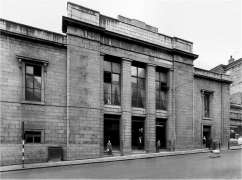
Similarly, a locality and micro-economy which has long been in decline, such as the Castlegate, can be revived only by rebuilding its resident population and base of custom and trade from the ground up. The buildings at the west end of Union Street (originally Union Place), used to be private houses; people did their shopping in the street markets or in Archibald Simpson’s New Market of 1842, Aberdeen’s first enclosed shopping mall.
One of the more positive developments in recent years is the conversion of the upper floors of these old buildings, often long out-of-use, into modern residential accommodation.
It is a pity that the long-proposed Bon Accord Quarter was put on hold, possibly whilst the proprietors of the two down-town malls assessed the impact of the Union Square development, south of Guild Street.
This writer was broadly in support of the outline scheme for the Bon-Accord Quarter, because it would have secured the desirable objectives of removing St Nicholas House and bringing Marischal College back into an appropriate usage; also because it confirmed and consolidated the traditional retail heart of Aberdeen as the premier shopping destination in the North-East, the natural and obvious location for up-market and quality retailers like Marks & Spencer, John Lewis, Debenham’s, Next etc., which serve to pull shoppers and visitors into the city centre to the benefit of all the other retailers and service-providers.
Contributed by Alex Mitchell.
